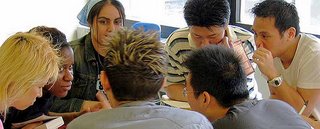- Don’t introduce subject-oriented questions until you’re sure students have fully understood how to form “normal” object-oriented questions using the Question Word -Auxiliary Verb -Subject – Main Verb rule. Spend some time revising this in the preceding lessons.
- This area is often introduced using sentences like John loves Mary and then getting the students to formulate pairs of sentences Who does John love? Who loves Mary? This can often turn into an exercise in mental gymnastics and create more confusion than it resolves. I prefer to avoid this approach and to work with different sentences, checking one last time that students understand and are using object-oriented questions accurately, and then moving on to focusing on subject-oriented questions in context.
- The context I usually use is a general knowledge quiz. Divide the students into groups and tell them that you’re going to give them a general knowledge test. They can confer on the answers and the group will get one point for each correct reply.

- Ask the questions, turning up some background music while they confer, so that they can’t hear what other groups are saying, but turning it down for the questions so that they hear you clearly. Ask about twelve questions, aiming at topics you feel the students should know but which might stretch them slightly. Repeat each question at least twice. The questions should be a mix of object-oriented questions : When did the first man walk on the moon? What does the formula H2O stand for? Where does the Dalai Lama live? and subject-oriented questions : Who played Obi Wan Kenobi in the original Star Wars films? Who discovered penicillin? Which country won the 2002 World Cup?
- Repeat the questions one at a time and elicit the answers. Give the points and decide who’s won.
- The students have now heard the questions at least three times. Ask them to look at their list of answers and use it to reconstruct the list of questions. Give them five minutes to do so.
- Elicit first the object-oriented questions and write them on one side of the board. Students should have got these right easily. Then elicit the other questions, which students may be floundering on. List them on the other side of the board and then elicit/feed in the differences between the sentences in the two groups and the reason.
- Murphy’s Essential Grammar in Use (CUP) provides some good practice activities for this area, and a short but useful on-line activity can be found here. If the listenings in the textbook you are using include an interview situation, this will probably contain examples of both types of questions and can be used for consolidation. As a freer final activity you can return to the quiz situation. In groups the students have to write six general knowledge questions to ask the rest of the class (they must know the answers).
Notes
(1) Object-oriented questions should really be called complement-oriented questions, as they may focus on an adverbial or other element of the complement rather than the object itself. However, the term object-oriented question (or often just Object question) is generally used, and I have followed the standard practice.
The questions are called "subject" and "object" oriented because of the grammatical element required by the answer. If I ask Who did you see in London? the answer is the object of the sentence : I saw John. The question is therefore oriented towards the object or, if you like, Who is the object of the verb in the question. This type of question is formed using Question word - Auxiliary verb - Subject - Main verb.
If on the other hand I ask Who gave you that book? both the question word and the answer are the subject of their sentences : Janet gave it to me. So the question is subject oriented. Here the question is formed using simply Question word - verb phrase.
Acknowledgement
Photo provided under Creative Commons Licence by Susan NYC via flickr

No comments:
Post a Comment